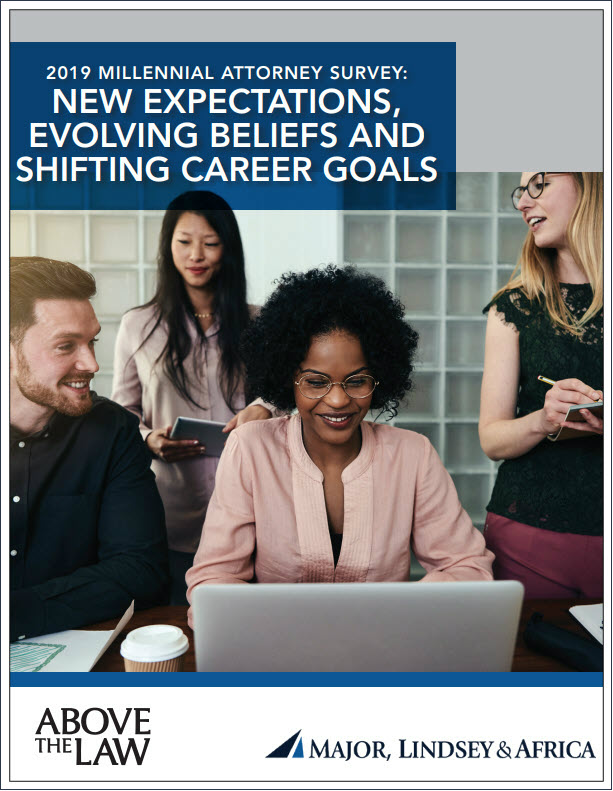 First off, I’d like to apologize to the editors at Above the Law and my readers (all three of them!) for not writing lately. The practice has been intensely busy of late, and I’m sorry that my ATL columns are one of the things that has had to give (along with sleeping and going on second dates). I miss writing these. I wanted to make it a point to write today, because yesterday I had my first Supreme Court visit.
First off, I’d like to apologize to the editors at Above the Law and my readers (all three of them!) for not writing lately. The practice has been intensely busy of late, and I’m sorry that my ATL columns are one of the things that has had to give (along with sleeping and going on second dates). I miss writing these. I wanted to make it a point to write today, because yesterday I had my first Supreme Court visit.
Some background: A friend of mine from way back when is a solo practitioner who takes prisoner civil rights cases. He got this case that was egregious and won at the district court level, and then the State of Illinois appealed and my friend argued it at the Seventh Circuit, winning as to liability (or I guess it’s called affirming?), but then the appellate court had a weird interpretation of how attorney’s fees are to be apportioned, so the case was reversed on the fee issue. My friend made a petition for a writ of certiorari to SCOTUS, which was granted.
First, an interesting thing about getting there. Apparently all these Supreme Court clinics at law schools monitor lower-court cases and have gotten good at figuring out which ones have a real shot. His case was one of them, so he had all of these law professors (and even some Biglaw partners) from across the country come out of the woodwork to contact him, all of them eager to pitch in on the petition and get another SCOTUS notch on their bedposts. My buddy thought it’d probably be best for the client if one of these people argued the case — he knows his skill is as a trial lawyer — and he went with the person who was most responsive (this guy).
Okay, enough background. I get there, and find out they only allow the first 50 people in line — at most — into the “permanent” seating area, and if you’re not one of the first 50, then you can still get in, but you can only stay in the chamber for three minutes. Once I was inside the building about to go in with the other three-minute folks, I told a couple of the pages it was my friend’s case, and they said there were some extra “permanent” seats and they graciously gave me one.
The chamber is small. I’ve been in federal district courtrooms which were larger. Heck, I’ve been in dining rooms which were larger. And it’s crowded. There’s virtually no space between the attorneys and the justices.
It’s really cool seeing all the justices together in person. I had seen most of them at various events over the years, but seeing them all together is almost surreal. The dais is elevated slightly but not much. They are right freaking there.
Here are my observations about the individual justices, who are seated outwards — in in order of seniority, except for the chief justice, who is in the center.
Gorsuch didn’t say a word, but appeared to be intensely following the dialogue.
Thomas didn’t say a word either, and appeared to be doing anything but following the dialogue. He kept leaning way way back in his chair (I was afraid he was going to fall over), looking at the ceiling, once holding the brief up to the light looking for hidden messages. He also chitchatted a bit during the argument with Breyer, who sits right beside him. So he wasn’t exactly silent and he definitely wasn’t taciturn (at all), but true to form he didn’t ask questions.
Kagan came across very well. She asked good questions and was very respectful. I believe she was the one who asked the typical moot court question of, “If we rule for you, what should we establish as the law?” She seemed to be the nicest justice. (By the way, does anyone know if she’s single? I could use more nice in my life.)
Sotomayor asked the most questions, interrupting the lawyers basically right away, and I guess was generally the toughest and most opinionated. One non-attorney member of our group is a tough cookie from New York, and Sotomayor was her favorite justice hands down.
Alito is a character. He had a funny hypothetical about his wife feeding him carrots for dinner and whether that would satisfy him, and that hypo flowed through into the other justices’ questions, so for a while they were all talking about Justice Alito’s carrots for dinner and his subsequent satisfaction level.
Ginsburg is more frail than when I saw her last, though she still has the authoritative questioner tone. She didn’t ask many questions, though the ones she did ask were pointed.
Kennedy didn’t ask many questions either, but his questions were clear and struck to the heart of the matter.
Breyer is interesting. He pressed on the weak points of each side’s case, not letting them get off easy. He asked the respondent a question that must have taken five minutes to fully explain, stopping a couple of times to ask the lawyer, “Are you still with me?” (He should take cues from Alito on how to make questions more entertaining.) He sits by Sotomayor, and that wing of the court did the majority of the questioning, even though the two of them are flanked by Thomas and Gorsuch.
Roberts commanded respect and asked good questions but isn’t as much of a character as some of the others. He wasn’t holding briefs up to the light or anything like that, nor inventing funny hypotheticals, though he did skillfully use hypotheticals in his questioning.
I’ll note that no justice was condescending nor demeaning, though a few such as Sotomayor seemed to tip their hand on which way they were leaning.
Each side got 30 minutes and the petitioner had a short rebuttal, and then it was over. The whole experience was illuminative, for it’s natural to get caught up in your own little corner of the law and to forget how broad law is and the experiences a person can have in our chosen profession. I’m fortunate to love what I do — though yeah, I wish I were able to sleep more — but arguing in front of SCOTUS, or to be like my buddy, who took a case from a prisoner on a contingency five years ago and yesterday got to see the highest court of the land argue about his fees: I guess that would be pretty good too.
For those who are interested, here is the case that is the subject of today’s column: http://www.scotusblog.com/case-files/cases/murphy-v-smith/.
Gary J. Ross is a partner at Ross & Shulga PLLC, which he co-founded in 2017 after running his own firm for four years and after several years in Biglaw and the federal government. Gary handles corporate and securities law matters for venture capital funds, startups, and other large and small businesses, as well as investors in each. You can reach Gary by email at Gary@RSglobal.law.















 Get a better starting point with attorney created legal documents, checklists, guides and more. »
Get a better starting point with attorney created legal documents, checklists, guides and more. » Gain a clear strategic advantage with the fastest answers and most valuable insights. »
Gain a clear strategic advantage with the fastest answers and most valuable insights. » Simplify your matter management, client communication and financial reporting in one seamless tool. »
Simplify your matter management, client communication and financial reporting in one seamless tool. »